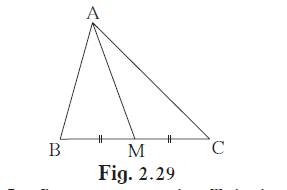Practice Set 2.2 | Q 4 | Page 43
In ∆ABC, point M is the midpoint of side BC.
If, AB2 + AC2 = 290 cm2, AM = 8 cm, find BC.

\[{AB}^2 + {AC}^2 = 2 {AM}^2 + 2 {BM}^2 \left( \text{by Apollonius theorem} \right)\]
\[ \Rightarrow 290 = 2 \left( 8 \right)^2 + 2 {BM}^2 \]
\[ \Rightarrow 290 = 2\left( 64 \right) + 2 {BM}^2 \]
\[ \Rightarrow 290 = 128 + 2 {BM}^2 \]
\[ \Rightarrow 2 {BM}^2 = 290 - 128\]
\[ \Rightarrow 2 {BM}^2 = 162\]
\[ \Rightarrow {BM}^2 = 81\]
\[ \Rightarrow BM = 9\]
\[ \therefore BC = 2 \times BM\]
\[ = 2 \times 9\]
\[ = 18 cm\]
Hence, BC = 18 cm.
Explanation:-
Given: In ∆ABC, BM=MC=1/2BC and AB²+AC²=2AM²+2BM²
To Find: BC
Proof:
Using BM=MC=1/2BC, we can say that BM=MC=BC/2.
Let’s apply Apollonius theorem for side AB,
AB²+AC²=2AM²+2BM²
Given AB=8, AC=√290 and AM=4 (as M is the midpoint of BC)
Substituting the given values in the above formula, we get:
8²+ (√290)²=2(4)²+2BM²
Simplifying the above equation, we get:
BM²=81
Taking square root of both sides, we get:
BM=9
As we know, BM=MC=BC/2. Substituting BM=MC=9, we get:
9+9=BC/2
18=BC/2
Multiplying both sides by 2, we get:
BC=18
Therefore, the length of BC is 18 cm.
Chapter 2 – Pythagoras Theorem- Text Book Solution
Practice Set 2.2 | Q 4 | Page 43
